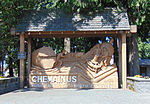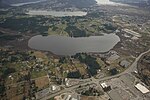Chemainus is a community within the municipality of North Cowichan in the Chemainus Valley on the east coast of southern Vancouver Island, British Columbia, Canada.
Founded as an unincorporated logging town in 1858, Chemainus is now famous for its 53 outdoor murals. This outdoor gallery has given birth to many businesses, including a theatre, antiques dealers, and eateries. The tourist industry stemming from the murals helped rejuvenate the town after its large sawmill closed in the early 1980s and was replaced by a smaller, more efficient, mill.
The name Chemainus comes from the native shaman and prophet "Tsa-meeun-is" meaning broken chest. Legend says that the man survived a massive wound in his chest from an arrow in battle to become a powerful chief. His people took his name to identify their community, the Stz'uminus First Nation, formerly the Chemainus Indian Band.
The railway arrived in the 1880s and by the early 1920s the town's population had ballooned to 600 persons. Chemainus was eventually designated a census populated area by Statistics Canada comprising the more built-up residential and commercial neighbourhoods. Its population had further grown to 3,035 residents by 2011. A larger more inclusive Chemainus area is customarily regarded as comprising part of the District of North Cowichan that lies north of the Chemainus River. This is the area covered by the Chemainus Advisory Committee set up as a consultation body by North Cowichan.
Chemainus Secondary School is located in the town, and serves as a secondary school for students living in Chemainus, Crofton, and Saltair.
A BC Ferry terminal is located in Chemainus, which provides service to Thetis Island and Penelakut Island (previously Kuper).
On 13 January 2006, a Boeing 737 aircraft was sunk off the coast in order to build an artificial reef. The sinking was documented in "Sinking Wings", an episode of the Discovery Channel series, Mega Builders.




